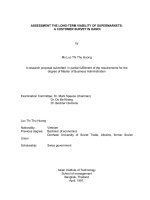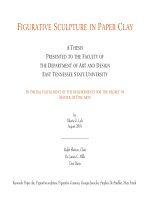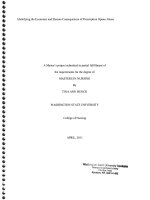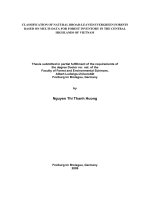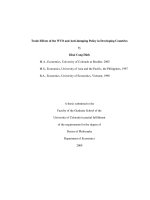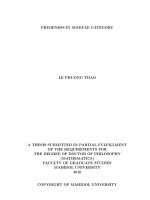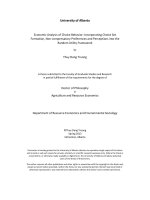FIGURATIVE SCULPTURE IN PAPER CLAY - IN PARTIAL FULFILLMENT OF THE REQUIREMENTS FOR THE DEGREE OF MASTER OF FINE ARTS ppt
Bạn đang xem bản rút gọn của tài liệu. Xem và tải ngay bản đầy đủ của tài liệu tại đây (1.96 MB, 53 trang )
FIGURATIVE SCULPTURE IN PAPER CLAY
by
Valarie G. Lyle
August 2001
A THESIS
PRESENTED TO THE FACULTY OF
THE DEPARTMENT OF ART AND DESIGN
EAST TENNESSEE STATE UNIVERSITY
IN PARTIAL FULFILLMENT OF THE REQUIREMENTS FOR THE DEGREE OF
MASTER OF FINE ARTS
Ralph Slatton, Chair
Dr. James C. Mills
Don Davis
Keywords: Paper clay, Figurative sculpture, Figurative Ceramics, Georges Jeanclos, Stephen De Staebler, Mary Frank
page 2
ABSTRACT
The artist discusses her Master of Fine Arts exhibition at East Tennessee State University, Carroll Reece Museum, Johnson
City, Tennessee, March 9 - 17, 2001. The exhibition marked her return to organic, gestural work. Works are figurative,
ceramic, sculpture, made of paper clay, ranging from 8-inch, wall mounted, bas-relief to life sized, full round figures. Most
are slab constructed, unglazed or lightly glazed with soda wash.
Topics discussed: the artist’s development, including the influences of Stephen De Staebler, in his treatment of the indi-
vidual in mass culture, and of Mary Frank, in psychological content and in the use of negative space; similarities with
sensuality in Georgia O’Keeffe’s flower paintings; paper clay technique and the work of Rosette Gault; ceramic workshops
in Appalachia; mythology and feminism as inspiration; the effect of nature and environment on art; and Georges Jeanclos.
Includes images and discussion of seventeen works and a brief video of the exhibit.
page 3
©
COPYRIGHT 2001, VAL LYLE
ALL RIGHTS RESERVED
Design consultant: Michael Garrett.
Photographs of current works by Tim Barnwell, Chris Stewart, and Val Lyle.
All other photos and digital video by Val Lyle, unless otherwise noted.
page 4
DEDICATION
To my brother, James,
who always believed in
me even when I didn’t,
and who kept every
scrap of artwork I threw
away, saying “You’ll
need this when you’re
famous.”
To my mother, Phyllis
Eggers Lyle,
who brought me back
home to East Tennes-
see, and who gave me
all my tenacity
plus hers.
page 5
ACKNOWLEDGMENTS
Thank you: Don Davis, for going out on a limb to keep me in the ETSU Ceramics program. Ralph Slatton, for supporting that
limb, and asking me the powerful question, “What do you want to do?” Dr. J. C. Mills, for teaching me the value of prioritizing
the right things. Lynn Whitehead Lehnert, for saying “If you think it and explain it to me, then we can figure out how to make
it.” You totally empowered me in making art and teaching art. John Steele, for offering perspective. Michael Garrett, for truth
and insight in the midst of chaos. Seth Piercy, for unwavering strength and support. Robert Reedy, for teaching me how to see
myself with humor and still to make good art. Mark Anderson, for working with me as a contemporary sculptor. Ethelia
Patmagrian, my first hands-on, real-life, totally capable woman figurative sculptor role model. Laura Bagwell, for teaching me
that black grass is OK if it helps the picture. V.G. Stern, for showing me that a woman could be tenacious well into her 70’s with
her chain-saw sculptures. The Carroll Reece Museum, Blair White, and all the folks working there. My mother, for keeping
good art on the walls and good books on the shelves. An art teacher, in a night class at a community college in Oahu, Hawaii, in
the 80’s. I don’t know your name, but thank you for saying, “If you really want to go to art school, you can find a way.” You were
right. Free and low-fee community help organizations. We need more. And so many kind people, for giving me encourage-
ment along the way.
Special thanks to my husband, Mark Smith. You gave me love and encourage-
ment enough so that I could make art again. “Thank you” is an understatement.
You have earned your honorary degree in ceramics from ETSU.
page 6
Abstract ————————————————————— 2
Dedication ———————————————————— 4
Acknowledgments ————————————————— 5
List of Figures ——————————————————— 7
Catalogue Index —————————————————— 8
Chapter Page
1. Introduction —————————————————— 9
2. Context ———————————————————— 14
Mary Frank ————————————————— 14
Stephen De Staebler—————————————— 18
Comparison of Frank and De Staebler —————— 20
Georgia O’Keeffe ——————————————— 21
3. Ceramic Paper Clay ——————————————— 22
Experimentation ——————————————— 22
Rosette Gault ———————————————— 24
A Commercial Source for Paper Clay ——————— 25
4. Catalogue ——————————————————— 26
5. Conclusion —————————————————— 44
Notes —————————————————————— 47
Bibliography ——————————————————— 49
Vita —————————————————————— 51
CONTENTS
page 7
LIST OF FIGURES
1. Portrait from Life, I.D. Eggers ——————— 10
2. Foam Rubber Series 3 —————————— 10
3. 3 Torsos ——————————————— 11
4. Tennessee Yakshi ———————————— 12
5. Mary Frank, Persephone ————————— 15
6. Sketch for Einstein’s Daydream —————— 16
7. Mary Frank, Where or When? ——————— 17
8. Stephan De Staebler, Seated Woman with
Quartered Abdomen ——————————— 19
9. 3-D O’Keeffe Flower Pot: #2 with Flower ——— 21
10. Orchid ———————————————— 21
11. Catharsis ——————————————— 23
12. Lovers #3 ——————————————— 24
13. Embrace, detail ————————————— 25
14. MFA Show, Carroll Reece Museum (video) — 26
15. Georges Jeanclos, Kamakura Number 1 ——— 45
page 8
CATALOGUE INDEX
1. A Difference of Opinion —————————— 27
2. Adam ———————————————— 28
3. Tennessee Yakshi ———————————— 29
4. Mars ————————————————— 30
5. Mercury, The Messenger ————————— 31
6. Torso Abstraction ———————————— 32
7. Home ———————————————— 33
8. Embrace ——————————————— 34
9. Lovers #4 with Flower —————————— 35
10. In Community ————————————— 36
11. Sketch for Einstein’s Daydream —————— 37
12. Einstein’s Daydream——————————— 38
13. Orchid ———————————————— 39
14. 3-D O’Keeffe FlowerPot: Pitcher Plant ———— 40
15. 3-D O’Keeffe Flower Pot: #2 with Flower ——— 41
16. Madonna ——————————————— 42
17. Lovers #3 ——————————————— 43
Catalogue —————————————— 26
page 9
INTRODUCTION
In early March, 2001 “International outrage escalated …as Afghanistan’s Taliban
militia pressed on with their ‘Islamic’ mission to smash ancient statues across the country.” [1]
They began blowing up the Colossal Buddha located at Bamiyan. This 175 ft tall sculpture had
been carved into the living rock some 2000 years earlier. [2] The event was called an interna-
tional crisis, but world wide public outcry could not save the figure. [3] The loss was called cata-
strophic to the history of human culture, art, and religion. That is the impact one figurative
sculpture can have.
The Bamiyan Buddha is especially important to me because it was lost at the very
time I was pondering why I make figurative sculptures. I was on the verge of thinking everything
figurative had already been done a thousand times. How much could it matter what I made? The
same week we studied the Bamiyan Buddha in Asian Art history class it was lost. The “coinci-
dence” was bone chilling, and the message was loud and clear: people do care. We make and
respond to figurative sculpture.
In the work presented here, I am continuing my 15-year exploration of the human
figure in clay. When I first started to learn how to control clay as a medium, accurate representa-
1
page 10
tion was important to me. I spent several years learning to form convincing lifelike portraiture
from live models and clients (figure 1).
While working on my BFA at the Ringling School of Art and Design in Sarasota,
Florida, I began experimenting with abstraction. My figures became very organic and sensuous
(figure 2). Those works were satisfying, but the series was interrupted. I moved to New York for
several years, where millions of people seem to be running around like crazy ants. It is no wonder
then, that the representation of the specific individual became even less important in my work.
Fig. 1
Portrait from Life,
I.D. Eggers
1992.
Air-dried clay, with
faux bronze patina.
10 x 7 x 7 in. Early
figurative work.
Fig. 2
Foam Rubber Series 3
1989.
Mattress foam, 30 x 50 x 30 in.
From my BFA show, Sarasota, FL.
Abstract, organic, sensuous.
page 11
While in New York, I made several series of torsos with no arms or legs and several
series of fragmented figures. In retrospect, I meant the amputations as a metaphor for the loss of
power I felt living there. The figures were usually struggling. They had not given up (figure 3).
Now that I have been away from New York for five years, my figures are not so
much about struggling. Sensuousness and movement have returned as major elements. The
figures are appearing more often in pairs rather than always so very alone. The reappearing pairs
may be couples, siblings, or lovers, or even my own muse whispering in my ear.
I am also now interested in nature and figurative art and am drawing inspiration
from mythology. Many examples exist from history where cultures have expressed their relation-
ship with nature beyond physical survival. In the West, I find the Green Man carved into ancient
Celtic lore. [4] Here, a human face is pictured regurgitating all that is vegetation. In the ancient
Fig. 3
3 Torsos
1991.
Each lifesize.
Ise Cultural Foundation,
at 555 Broadway, New
York, NY.
page 12
East, the femme Yakshi and the homme Yaksha [5] are the figurative and voluptuous nature
deities that I took inspiration from (figure 4, catalogue no. 3).
These current figurative sculptures are much more archetypal in their representa-
tion than my previous work, going beyond the specific individual but also inclusive of individu-
als. I hope the use of abstraction helps to bring the viewer to a more primitive, subconscious
engagement with the works. I am influenced by Carl Jung’s ideas of archetypes and the subcon-
scious. The two living figurative ceramic sculptors that I identify strongly with, Mary Frank and
Stephen De Staebler, also cite direct influences with Jungian archetypes and mythological repre-
sentations of the human psyche.
I am comfortable working within my subconscious. While the intellect plays a
significant role in my art, down deep I don’t trust the intellect. Intuitive, emotional, and sub-
conscious drives are my guide. I often start with clay not having a predetermined image in mind.
When I delve as deep as I can into my psyche—and myself—I go to a semiconscious dream
place. This dream place is about sensuality. When I say sensuality, I am talking about the pure
senses—taste, touch, smell, sound, sight. Maintaining a physical relationship with nature in the
environment where I live plays significantly in my art and well-being. For my recent work, the
work discussed here, touch and sight are the subjects. In five of my past exhibitions an original
audiotape on a continuous loop was a part of the experience. At the opening for the work pre-
sented here spring breezes brought in the scent of fresh flowers, delicious homemade food was
served and a live jazz duo played great music.
All of the works presented in this catalogue are ceramics made with paper clay.
There are freestanding and wall-mounted, bas-relief works. Size varies from 6 inches to life-sized.
Go to catalogue
Fig. 4
Tennessee Yakshi
2001.
page 13
In the following chapters, I explore this body of work. In chapter 2, I will discuss
my artistic development by isolating the most significant art historical influences, especially
Mary Frank and Stephen De Staebler. In chapter 3, I will discuss my coming to know and love
the medium of paper clay. In chapter 4, I will discuss briefly each sculpture presented here. In
chapter 5, I will briefly summarize and project my future direction.
page 14
2
CONTEXT
In the next few pages I will discuss two living figurative ceramic artists who have
had significant influence on me, Mary Frank and Stephen De Staebler. I will discuss each artist
separately, and then I will have a brief comparison of the two. I will then briefly touch upon
another artist whose works resonate with some of my current explorations, Georgia O’Keeffe.
MARY FRANK
Lynn Whitehead Lenhert, who was head of ceramics at ETSU but out on leave,
suggested a book to me. It was Mary Frank’s monograph by Hayden Herrera [8]. What I saw in
this book was an artist who had absolutely broken new ground in construction methods, compo-
sitions, and the handling and manipulation of clay slabs towards a figurative sculpture. Her use
of positive/negative space challenges even an experienced viewer, redoubled by changing symbolic
scale and changing imagery as a piece is viewed from different angles. Her flat slabs melt into
ocean waves upon turning a corner. Usually there is a solitary figure, confronting or experiencing
life’s journeys. Birth, death, sexuality, fear, and sensory experiences dominate her subjects. Mary
sculpts strong women in strong gestures of clay. Even depicting a woman in heightened sensual-
“Despite
variations of style and
philosophical intent, the
human figure, male and
female, has been the
primary subject matter for
the artist in Western art
since the ancient Greeks
and remains the central
object of study in art
schools today.” [6]
“[Clay] is
the most impressionistic
material I know” — Mary
Frank [7]
page 15
ity, Mary’s figures deal with the psychic state of the subject (figure 5). The sculptures are every
woman; they are everyone.
I had to put the book down and simply try to absorb what I thought I saw. It went
that way for several weeks, me peeking at a few pages at a time, and then setting it aside again. It
didn’t scare me and I wasn’t jealous. I felt like I was looking at myself in some kind of mirror.
This had happened to me once before, discovering Magdalena Abakanowicz in a 1992 exhibition
at Marlborough Gallery in New York while working in a closely related medium. In two months
Fig. 5
Mary Frank
Persephone
1985.
Ceramic in five parts.
27 x 73 x 40 in. Collection
of the Metropolitan
Museum of Art, New
York, NY. Gift of Seavest
Private Investments,
1997.
Photographed by Ralph
Gabriner. Used with
permission of Mary
Frank.
page 16
time, I was able to read only a few pages, possibly turn through the first half of the book, when a
friend needed to borrow it. For about the next year I was without the book, but I believe it was
for the better. Mary’s work had such an impact on me, I think it was good for me to be working
with the impression of her sculptures, rather than referring to actual photographs of her sculp-
tures.
What I was most taken with was her explorations into figure-ground relationships,
her fresh and gestural 3-D sketches in clay. These works turned my head inside out. I had been
thinking about relatively simple differences in scale for psychological content, or a figure simply
piercing a ground-plane. Mary Frank’s work is extremely sophisticated in these areas. She
worked in all types of materials until she found her stride in clay at the age of 36, combining
with her figures additional subject matter including horses, other animals, fish, flowers, ferns
and ocean waves.
As a direct result of Mary Frank’s influence in figure-ground relationships, both
Sketch for Einstein’s Daydream (figure 6, catalogue no. 11) and Einstein’s Daydream (catalogue
no. 12) were completed for this exhibition.
For serendipity’s sake, I had curiously remained on a mailing list for a nonprofit
organization called “Artists talk on Art” in New York City. [9] There, for spring of 2001, a slide
lecture by Mary Frank was listed. It fell during the spring break of the semester this thesis was
due. A search for economical plane fare gave a round-trip bargain. I flew to New York for 2 1⁄2
days to sit in an audience of an unknown number, hoping to just be able to see her from a rea-
sonable distance. A public introduction to Mary Frank was given by Eleanor Munro, on the
Fig. 6
Sketch for Einstein’s
Daydream
2001.
Go to catalogue
page 17
occasion of the re-issuance of her book titled Originals: American Women Artists, which includes
a chapter on Mary Frank. [10]
For her slide presentation, Mary used dual projectors to walk the audience through
her art’s progression. I was familiar with most of the information regarding her earlier ceramic
works from Hayden Herrera’s book. [11] For the last ten years or so, Mary has concentrated on
prints and paintings, particularly using a large triptych format that mounts on a wall and can be
opened and closed like a book to reveal a different work (figure 7). Even while using a flat for-
mat, Mary has invented ways to give layers to her works, which still incorporate nature, animals,
myths and archetypes. What struck me most about Mary Frank’s slide lecture was the equal
enthusiasm she paid to a humanitarian effort she promotes that provides solar cookers to third
Fig. 7
Mary Frank,
Where or When?
1999.
Triptych, inside view.
Oil and acrylic on
board. 48 x 96 in.,
open.
Photographec by Jerry
L. Thompson. Cour-
tesy DC Moore Gal-
lery, New York, NY.
page 18
world families. [12] In addition to the ability to safely cook food without having to travel danger-
ous miles in search of rare wood fuel, the solar cookers also provide a means to easily pasteurize
water in areas where water-born sickness is rampant. The double benefit was a chance for the
completely defoliated landscape to begin healing. Even in the spotlight organized towards her
and her art, Mary Frank took the opportunity to educate us as to how we could easily make a
huge difference in the “bigger picture” of the world.
Mary Frank. A thousand tiny and major events lined up that we could be comfort-
able speaking together. She invited me to go with the inner group to dinner. I went. She pulled
up a chair beside her at the end of the table and invited me to sit with her. I did. She asked me
why I had chosen her for a mentor. I said, “You have already been at a place on a path that I
find myself at now. I want to learn as much as I can from you, and perhaps save a few steps.”
She seemed to accept that, and we spoke until close to midnight. I walked with her out into a
cool, misty rain in Soho long enough to see her into a cab. My feet never touched ground as I
walked up to 26th Street in my old neighborhood, passing Blue Man Group as they were letting
out of a performance, blue kisses and all, through the East Village.
Mary and I have spoken a few times since. To be near an artist you admire cannot
be underestimated. She is extraordinarily kind and centered. I am fortunate to have met her.
STEPHEN DE STAEBLER
De Staebler’s work (figure 8) made a great impression on me the first time I saw a
reproduction of it in a magazine while I was studying sculpture at Ringling School of Art. I
wasn’t sure what I was looking at. It looked old, real old. I couldn’t tell the scale, couldn’t tell if
“A life
without making things
that tell you who you are
and what you feel is not
enough. So I make
things.” — Stephen De
Staebler [13]
page 19
it might be a real person all burnt up in a molten lava flow, or if somebody even made that thing
I was looking at. And if somebody had made that, I was shocked at the nerve, the boldness of
presenting the human species in such an unflattering representation. Ten years later, when my
work became dark while living in New York City, his work helped me understand what I was
doing: Donald Kuspit, noted art critic and interpreter of De Staebler, writes,
De Staebler articulates the secretly surviving rawly human being within the stream-
lined, efficient functionary demanded by society in its pursuit of progress and technol-
ogy. His archaic figure represents the alive but devastated self within the efficient
technocrat that is the ideal modern person. De Staebler’s archaic figures are wounded
survivors of the streamlining process that robotizes human beings into efficient opera-
tors. [14]
According to Kuspit, De Staebler himself cites Jungian influences, specifically his
theory of the psyche. Kuspit draws revealing analogies between Jung’s Anima/Animus and De
Staebler’s female and male figures, and describes convincingly the Steles in terms of Jung’s
conception of a “shadow side” to the psyche. De Staebler feels that we have gained comfort and
technology at great expense to the health of the environment and the health of the human
psyche. [15] His figures are in ruins, in fragments to show this state of consciousness.
It was this contradiction between organized, “efficient” urban living and what I felt
was an inner need for connection with the environment and living on a human scale that led me
to my work in New York. There, I feel my sculpture was animated by this shadow side.
Fig. 8
Stephen De Staebler
Seated Woman with
Quartered Abdomen.
1978.
Stoneware, porcelain,
slab built, stains. Mint
Museum of Art, Char-
lotte, NC. From the
Allan Chasanoff Ce-
ramic Collection.
page 20
It is interesting to note the serendipitous beginning to De Staebler’s work. Early in
his career he made sculptures of landscapes and sculptures of figures, but it was relocating to a
house on a hill that brought the two together. Unsuccessful attempts with his figure-fragments
were tossed beside the house and they began to pile up against the earth bank. One day he
looked at the earth/figure pile differently and the rest is history. [16]
COMPARISON OF FRANK AND DE STAEBLER
It is interesting that both Stephen De Staebler and Mary Frank are concerned with
the threats to environmental well being and feel that references to this are made in their works.
While similarities between Mary Frank’s and De Staebler’s work include the obvious—ceramic,
figurative, fragmented, minimal surface decoration, usually a single figure depicted in a non-
idealized manner—less obvious similarities are powerful. Both artists are peeling away layers.
Over and over again, their sculptures are peeled apart to reveal what is below. And both artists
blur where the earth stops and the individual begins. What is below is the big difference between
them. When Stephen De Staebler peels apart his psychically charged sculptures he revels the
bones of humanity below the layers. When Mary Frank peels apart her psychically charged sculp-
tures she reveals the living inner psyche of the figure’s archetype. Hers are alive, his are very
dead.
In reference to my work, I feel that while I was living in New York City I was very
much aligned with De Staebler’s aesthetic. Now I feel much more aligned with Mary Frank’s
aesthetic of present and future possibilities.
page 21
GEORGIA O’KEEFFE
The 3-D O’Keeffe Flower Pot with Flower (figure 9, catalogue no. 15) and it’s com-
panion piece, Pitcher Plant (catalogue no. 14) were named on behalf of American born Georgia
O’Keeffe, who is most noted for her large sensuous paintings of flowers. [17] Although many
people insisted they were sexual in nature, Ms. O’Keeffe herself always insisted that they were
not, that she was just painting a flower. American mixed media artist Judy Chicago is direct,
even though abstracted, in her ceramic depictions of female sexuality at the famous installation
the Dinner Party.
For me, I am happy to marvel out loud at how similar an orchid really is to our own
sexuality, and perhaps compose a bit myself in clay to playfully, wonderfully, and respectfully
reveal those similarities (for example, Orchid, figure 10, catalogue no. 13). I believe it is a chal-
lenge to represent healthy sensuality and sexuality in today’s Western, North American, East
Tennessee art environment. Lovers #4 (catalogue no. 9) is another effort in this direction.
Fig. 9
3-D O’Keeffe Flower Pot:
#2 with Flower
2001.
Fig. 10
Orchid
2001.
Go to catalogue
Go to catalogue
page 22
3
CERAMIC PAPER CLAY
Paper clay can change ceramic sculpture, as we know it, for the better.
From my training in bronze, sculpture and ceramics at Ringling School of Art &
Design, clay was my first choice as a figurative sculptural medium. It was clay—simple clay—
that responded immediately to my touch and fed my inspirations. The goal was to find a perma-
nent direct solution, rather than the molds I had been forced to use with bronze casting. I found
myself pushing the material to its limits, and wanting more from it. The trouble I encountered
was that large pieces would break while I tried to load them into a bisque kiln. Regular greenware
clay was simply too fragile for the methods I was attempting.
A rumor circulated about a material called “paper clay”. The concept was simple
and as ancient as adobe itself: Introduce cellulose fiber to whatever clay you are working with for
the multiple benefits of greenware strength, moisture wicking for fast even drying, and wet on
dry applications.
EXPERIMENTATION
It was a ceramics student at ETSU named Troy who first gave me his paper clay
recipe: one Wall Street Journal and two Wednesday Johnson City Press newspapers torn to bits.
page 23
Leave in the big dough mixer (our clay mixer), in water, with the beaters going for a couple of
hours. Add to this enough dry mix to make 100 lb of wet clay. He suggested I experiment a lot,
and told me about another stu-
dent named Suzanne who might
have a book on the subject. I tried
many experiments, with all sorts
of paper at all sorts of percent-
ages. I had some great results and
some dismal failures.
An early, encourag-
ing experiment was using the
paper clay to repair a bisque piece
that broke into pieces during
firing (Catharsis, figure 11).
Literally, the largest piece intact
was a leg. I patched it up with the
paper clay and refired. It held.
The culmination of this exploration was two life-sized, high bas-relief figures. While
they were pit-firing overnight, a security guard at ETSU saw the smoke, dumped them out of
the garbage cans I used for firing onto the 20° F concrete and hosed them off, while they were
red hot, with freezing water. They survived. The velvety smoke that permanently penetrating the
surfaces of my figures seemed to speak about the subconscious.
Fig. 11
Catharsis
2001.
Bisque clay,
with paper
clay. 18.5 x 15
x 11.5 in.
page 24
I began making waves and ripples of paper clay just for their own beauty, pit-firing
them just to see how the smoke would kiss them each time. Pushing this new medium, I made a
two-foot tall standing figure overnight in paper clay, using a blow dryer to stiffen the legs as I
built upwards. There were no cracks, and it dried, uncovered, quickly. This success gave me
confidence to experiment further. Next I made a figure out of a large slab and multiple-fired it
(Madonna, catalogue no. 16). After that, I tried a pair of larger figures, on a base, with thin,
extruded legs. These I titled Lovers # 3 (figure 12, catalogue no. 17).
ROSETTE GAULT
I finally got around to asking Suzanne about her experiences with paper clay. She
brought in a tattered book by Rosette Gault titled Paper Clay. [18] Ms. Gault had made paper
clay the subject of research while she was a resident artist some 10 years ago. With the help of
friends, she had done numerous studies and experiments enough to publish a small book. I
highly recommend this book and it’s subsequent follow-up book to anyone interested in paper
clay. It will save you weeks of reinventing the wheel, and I agree with all of it with one exception.
I found I could make paper clay easier and quicker by starting with warm water in
the dough mixer we use for a clay mixer, adding toilet tissue, about 4 rolls to a 100 lb batch,
letting the beaters run a while, say five minutes, then adding dry mix. A small amount of Vee
gum T, say 1%, and 1/4 cup of vinegar makes a perfect batch. The book reaffirmed all my tests,
plus gave me more working knowledge as well. Paper clay fires the same as the clay would ordi-
narily, perhaps even a cone higher. It accepts the same glazes and stains as the clay normally
Fig. 12
Lovers #3
2001.
Go to catalogue
page 25
would. Any clay can be paper clay with the introduction of cellulose. My best experiments came
from using the easily broken-down bathroom tissues. You could not tell the difference between
most fired regular clay and paper clay works by looking at them. The difference would be slightly
lighter weight after the cellulose fiber burns out, and tremendous green ware strength.
A COMMERCIAL SOURCE FOR PAPER CLAY
Facing my last semester, I made some hard decisions. I gave up the backbreaking
job of mixing my own paper clay and decided to buy a ton from the only east coast supplier I
could find at that time, Axner Company in Florida. [19] I knew that I was going to have my
thesis show at the Carroll Reece Museum, so I took a dozen different clay samples to check color
under their lights and against their walls before I ordered a ton. Shipping cost was half again.
Bad weather nationwide skewed the arrival date just enough to hit the surprise early closing of
ETSU one December Friday before holidays. So, I sat in below freezing temperatures in my
unheated van to meet the truck and unload the ton myself. I was on my way. The first piece I
made from my thesis ton was the big double backs I call Embrace (figure 13, catalogue no. 8).
Fig. 13
Embrace, detail
2001.
Go to catalogue
